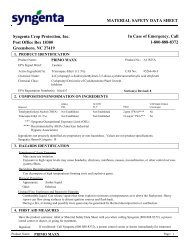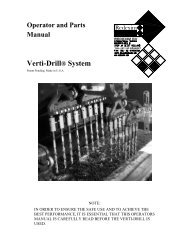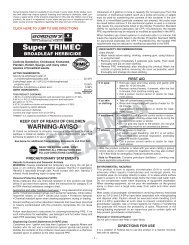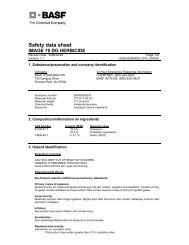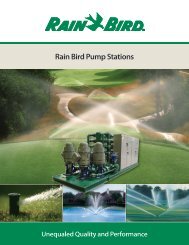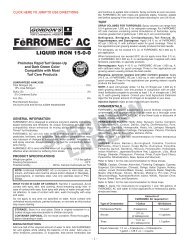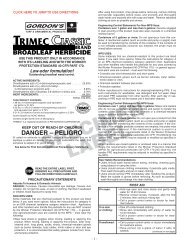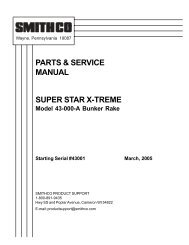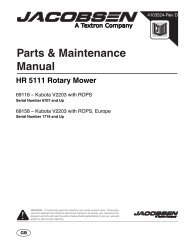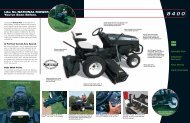turfcat 500 series - Golf Ventures
turfcat 500 series - Golf Ventures
turfcat 500 series - Golf Ventures
You also want an ePaper? Increase the reach of your titles
YUMPU automatically turns print PDFs into web optimized ePapers that Google loves.
MAINTENANCE 4<br />
4.8 CHARGING BATTERY _____________________________________________________<br />
! WARNING !<br />
Charge battery in a well ventilated area. Batteries<br />
generate explosive gases. To prevent an explosion,<br />
keep any device that may create sparks or flames<br />
away from the battery.<br />
To prevent injury, stand away from battery when the<br />
charger is turned on. A damaged battery could<br />
explode.<br />
2. Whenever possible, remove the battery from the<br />
tractor before charging. If battery is not sealed,<br />
check that the electrolyte covers the plates in all the<br />
cells.<br />
3. Make sure the charger is “Off”, then connect the<br />
charger to the battery terminals as specified in the<br />
charger’s manual.<br />
4. Always turn the charger “Off” before disconnecting<br />
charger from the battery terminals.<br />
1. Refer to Section 4.6. Read the Battery and Charger’s<br />
manual for specific instructions.<br />
4.9 HYDRAULIC HOSES _______________________________________________________<br />
! WARNING !<br />
To prevent serious injury from hot, high pressure oil,<br />
never use your hands to check for oil leaks, use paper<br />
or cardboard.<br />
Hydraulic fluid escaping under pressure can have<br />
sufficient force to penetrate skin. If fluid is injected into<br />
the skin it must be surgically removed within a few<br />
hours by a doctor familiar with this form of injury or<br />
gangrene may result.<br />
1. Always lower implements to ground, disengage all<br />
drives, engage parking brake, stop engine and<br />
remove key before inspecting or disconnecting<br />
hydraulic lines or hoses.<br />
2. Check visible hoses and tubes daily. Look for wet<br />
hoses or oil spots. Replace worn or damaged hoses<br />
and tubes before operating the machine.<br />
3. The replacement tube or hoses must be routed in<br />
the same path as the existing hose, do not move<br />
clamps, brackets and ties to a new location.<br />
4. Thoroughly inspect all tubes, hoses and connections<br />
every 200 hours.<br />
IMPORTANT: The hydraulic system can be<br />
permanently damaged if the oil becomes<br />
contaminated. Before disconnecting any hydraulic<br />
component, clean the area around the fittings and<br />
the hose ends to keep impurities out of the system.<br />
a. Before disconnecting any hydraulic component,<br />
tag or mark the location of each hose then clean<br />
the area around the fittings.<br />
b. As you disconnect the component, be prepared<br />
to assemble plugs or caps to the hose ends and<br />
open ports. This will keep impurities out of the<br />
hydraulic system and also prevent oil spills.<br />
c. Make sure “O” rings are clean and hose fittings<br />
are properly seated before tightening.<br />
d. Keep the hose from twisting. Twisted hoses can<br />
cause couplers to loosen as the hose flexes during<br />
operation resulting in oil leaks.<br />
e. Kinked or twisted hoses can restrict the oil flow<br />
causing the system to malfunction and the oil to<br />
overheat and also lead to hose failure.<br />
15



